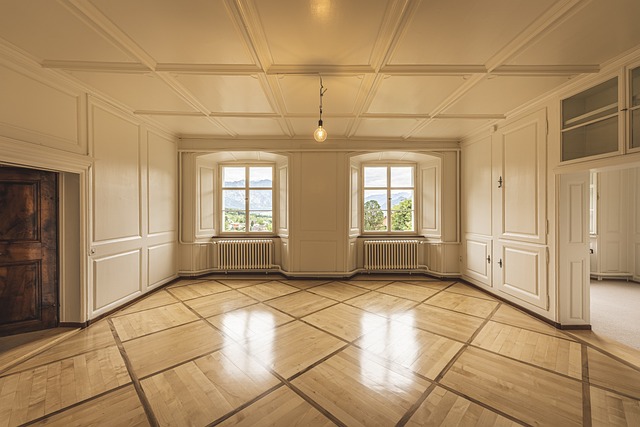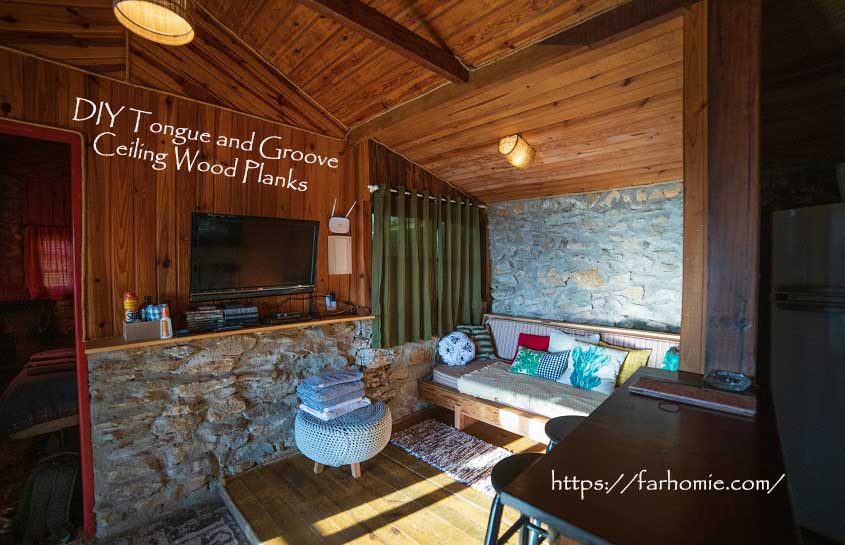Nowadays the craze for DIY projects is increasing and people are looking for innovative ideas to make their homes unique and stylish. One popular trend is to transform the ceiling using wooden planks using Tongue and Groove Ceiling. This technique not only increases the aesthetic appeal but also gives the home a rustic and classy look.
The Tongue and Groove Ceiling wood planks are designed in such a way that each plank easily fits into each other, giving a seamless and smooth finish. This DIY project requires a little effort and creativity but the result is worth it. You can give a unique touch to your living space by customizing your ceiling yourself. Come on, let’s explore how you can also implement this DIY project at your home!
What is Tongue and Groove Ceiling?
Tongue and Groove Ceiling is a unique and practical design technique used to connect wooden planks. Each plank has a “tongue” on one side and a “groove” on the other, so the planks fit easily into one another. This method results in a seamless and smooth ceiling surface, without any gaps.
Tongue groove ceilings are very popular because they give a home a rustic, warm and sophisticated look. These ceilings are not only decorative, they are also durable and long-lasting. This technique is appreciated by DIY enthusiasts because it is relatively simple to install. You can use it in the living room, bedroom, or even kitchen to give your space a natural and stylish vibe. Tongue groove ceiling is a timeless and versatile option that can enhance every interior.
How to install tongue and groove boards on a ceiling?

Installing Tongue and Groove Ceiling is a rewarding DIY project that can give your home a unique and classy look. It is important to understand this process step-by-step so that your work is perfect. Let’s understand how to do it:
1. Prepare the Ceiling
First, clean and smooth the ceiling surface so the boards fit properly. If the old ceiling is uneven, screw in new wooden furring strips at 16-inch intervals to create a strong, level base. Make sure the furring strips are parallel and uniformly spaced, as this ensures alignment of the boards. It is also important to mark and adjust electrical fixtures or vents so there are no issues after installation.
2. Measure and Cut Boards
Measure and cut tongue and groove boards to the accurate dimensions of the ceiling. Use a circular saw or miter saw to keep the edges clean and precise. Cut the boards one at a time, and don’t cut all the boards at once to make last-minute adjustments. Be sure to smooth the edges with sandpaper after each cut.
3. Locate the Joists
It’s important to locate the ceiling joists so that the boards attach securely and distribute the weight of the ceiling evenly. Use a stud finder to mark the exact positions and ensure that your hardware will fit directly into the joists. Mark the points of each joist with a pencil to avoid confusion during installation.
4. Start Installation
Start the installation process at one corner and ensure that the first board is perfectly straight, as this will determine the alignment of the other boards. Carefully place the first board tongue side up against the wall, keeping the groove side open. Place nails or screws through the tongue of the board at an angle, ensuring the board is movement-free.
5. Fit the Boards Together
When fitting the second board, carefully slide the tongue into the groove of the first board. Use a rubber mallet to make the boards fit snugly, but apply light force so as not to damage the wood. Use a spacer to fit each board tightly, which will prevent gaps.
6. Secure Each Board
Fix each board securely by placing nails into studs or joists. Make sure the screws and nails are completely countersunk so that the surface is smooth and there are no problems during finishing. If the boards do not fit tightly, remove them, align them and then reinstall.
7. Finish the ceiling
In the last step, trim the edges and joints to give them a clean and polished look. You can stain, varnish or paint the boards to suit your room’s decor. Use a protective coat for finishing, which protects the wood from moisture and damage.
Tips:
- Work with patience and precision for a professional finish.
- Don’t forget to keep the boards in the room for 24-48 hours to acclimatise before installation.
- Use good quality wood and tools to maintain both durability and aesthetics.
Installing tongue groove ceiling is a little time-consuming, but the result elevates the overall look of the home and adds a timeless charm.
Benefits of Tongue and Groove Ceilings
Tongue and Groove Ceiling is a stylish and functional option that enhances the interior of your home. These ceilings are not only visually appealing, but they also have many other practical benefits. Let’s understand its advantages in detail:
1. Aesthetic Appeal
Tongue groove ceilings give your room a warm and rustic vibe. The seamless design of wooden planks creates a natural and classy look, perfect for both traditional and modern interiors. You can customize them to suit your decor by staining, painting or varnishing them.
2. Durability
Wooden tongue and groove ceilings are durable and offer long-lasting performance. With proper maintenance, they withstand moisture and wear and tear. These ceilings are sturdy and become a dependable feature of your home.
3. Easy Installation
Tongue and groove boards are relatively easy to install. Their interlocking system makes each plank fit snugly with each other, making installation fast and efficient. If you enjoy DIY projects, this can be a rewarding task.
4. Seamless and Gap-Free Finish
This technique achieves a smooth and gap-free finish to the ceiling. The tongue and groove design of the boards prevents uneven gaps, ensuring a professional and neat look.
5. Sound Insulation
Tongue groove ceilings help with sound insulation. The layering of wooden planks reduces noise, making the room peaceful and quiet. This is especially beneficial for bedrooms and living areas.
6. Versatility in Design
Tongue and groove ceilings are versatile and can be used in multiple styles. You can install them in horizontal, vertical or diagonal patterns. The different textures and finishes of the wooden planks give you unlimited customization options.
7. Increased Property Value
If you want to increase the value of your home, tongue groove ceilings are a great investment. They add a timeless charm and unique feature that can attract potential buyers.
8. Low Maintenance
Tongue groove ceilings are low maintenance. Regular dusting and occasional polishing maintain their natural look. These ceilings also resist cracks or chips, making them even more reliable.
Tongue and Groove Ceiling is not just a design element, it is a perfect combination of practical benefits. If you want your home to be stylish, durable and functional, this is an excellent choice that will elevate your living space.
Rising Popularity of Tongue and Groove Ceilings

Tongue and Groove ceilings are becoming quite popular these days, thanks to their timeless appeal and functionality. These ceilings add a classy touch to every type of interior—from traditional to modern. Let’s understand why Tongue and Groove Ceiling Planks and Tongue and Groove Pine Ceiling are in such demand.
1. Timeless Aesthetic Appeal
The seamless design and natural wood finish of the Tongue and Groove Ceilings give every room a sophisticated and cosy vibe. The lightweight and warm tone planks of Tongue and Groove Pine Ceiling are a perfect choice for rustic and elegant interiors. These ceilings are quite versatile and can be customized to suit your decor through stain, varnish, or paint.
2. Enhanced Durability
Wooden ceilings, especially Tongue and Groove Ceiling Planks, are quite durable. With proper care, they resist moisture, cracks, and daily wear and tear. The lightweight and sturdy nature of pine wood makes these ceilings long-lasting and perform in every season.
3. Ease of Installation
One of the major reasons for the popularity of these ceilings is their simple installation process. The interlocking system of Tongue and Groove Planks makes the boards fit snugly, which makes installation fast and hassle-free. This is also an ideal choice for DIY enthusiasts who can save both their time and money.
4. Eco-Friendly and Sustainable Option
Eco-friendly interiors are the trend these days, and Tongue and Groove Pine Ceiling aligns perfectly with this trend. Pine wood is a renewable resource that meets the demand for environment-friendly construction materials. Its natural insulation property also contributes to energy efficiency.
5. Modern and Rustic Fusion
These ceilings are a perfect combination of modern and rustic design styles. While modern interiors prefer clean and minimalist designs, Tongue and Groove Ceilings add a unique charm through the wooden texture. Options of horizontal, vertical, and diagonal patterns ensure that every room looks unique.
6. Better Sound Insulation
The layered structure of ceiling planks effectively absorbs noise, making them ideal for homes, offices, and studios. Their popularity is growing because of their soundproofing feature, especially for bedrooms and living rooms.
7. Customizable Finishes
Today people want to make their interiors unique and personalized. The customization-friendly nature of Tongue and Groove Ceiling Planks further increases their demand. You can prefer a natural wood finish or paint them according to your room decor.
8. Property Value Booster
Real estate experts say that the installation of Tongue and Groove Ceilings can significantly boost the value of your home. It has become a premium feature that is very attractive to buyers.
Tongue and Groove Ceilings are gaining popularity because they are a perfect balance of beauty and practicality. Tongue and Groove Pine Ceiling and Tongue and Groove Ceiling Planks are becoming the favourite choice of every homeowner due to their low maintenance, easy installation, and stunning appearance. If you want to give your interiors a modern yet timeless touch, then these ceilings are a perfect option that will take your home to the next level.
DIY White Oak Tongue and Groove Ceiling
If you want to create a stylish and sophisticated look in your home, DIY White Oak Tongue and Groove Ceiling is a perfect choice. The natural texture and light color tone of white oak wood give your interiors an elegant and fresh feel. The installation of this ceiling can be a little time-consuming, but if you follow the step-by-step guide, you can install a beautiful ceiling yourself.
First, you need to smooth and clean the ceiling surface. Then, just like Cedar Tongue and Groove Ceiling, measure and cut the White Oak boards. Cedar wood is also popular for outdoor settings, but the dense grain and sturdy nature of White Oak make it ideal for use in both interior and exterior.
In comparison to outdoor Tongue and Groove Ceiling, the texture of White Oak suits indoor environments much more. You can finish your ceiling with varnish or lacquer to maintain its natural look and durability. When installing, ensure the boards are tight and properly aligned. This will give your DIY project a professional and polished look.
If you want a classy and durable look, then DIY White Oak Tongue and Groove Ceiling is a very satisfying and long-lasting option.
Conclusion
DIY Tongue and Groove Ceiling Wood Planks is a fantastic and rewarding project that can instantly elevate the interiors of your home. Whether you choose White Oak, Cedar Tongue and Groove Ceiling, or any other wood finish, these planks add a natural and timeless look to your space. Installation can be a little challenging, but with a little patience and the proper tools, you can install your dream ceiling yourself. The result of your DIY project will add a unique and classy touch to your home decor that will be durable and low-maintenance in the long term. If you want a combination of creativity and functionality in your home improvement projects, Tongue and Groove Ceilings are the best option.
FAQs:
Q: What is a Tongue and Groove Ceiling?
A: A ceiling with interlocking wood planks, where one plank has a “tongue” and the other a “groove” for a seamless fit.
Q: Can Tongue and Groove Ceilings be Installed by Myself?
A: Yes, with proper tools and patience, you can install Tongue and Groove Ceilings as a DIY project.
Q: What Types of Wood are Best for Tongue and Groove Ceilings?
A: Popular woods include Pine, White Oak, and Cedar, with Cedar being ideal for outdoor installations due to its weather resistance.
Q: Is Tongue and Groove Ceiling Durable?
A: Yes, it’s durable, moisture-resistant, and can withstand wear and tear with proper maintenance.
Q: Can I Paint or Stain Tongue and Groove Ceilings?
A: Yes, you can paint or stain the ceiling to match your desired look or enhance the natural wood finish.
Read More:

